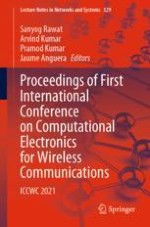This book includes high-quality papers presented at Proceedings of First International Conference on Computational Electronics for Wireless Communications (ICCWC 2021), held at National Institute of Technology, Kurukshetra, Haryana, India, during June 11–12, 2021. The book presents original research work of academics and industry professionals to exchange their knowledge of the state-of-the-art research and development in computational electronics with an emphasis on wireless communications. The topics covered in the book are radio frequency and microwave, signal processing, microelectronics and wireless networks.
